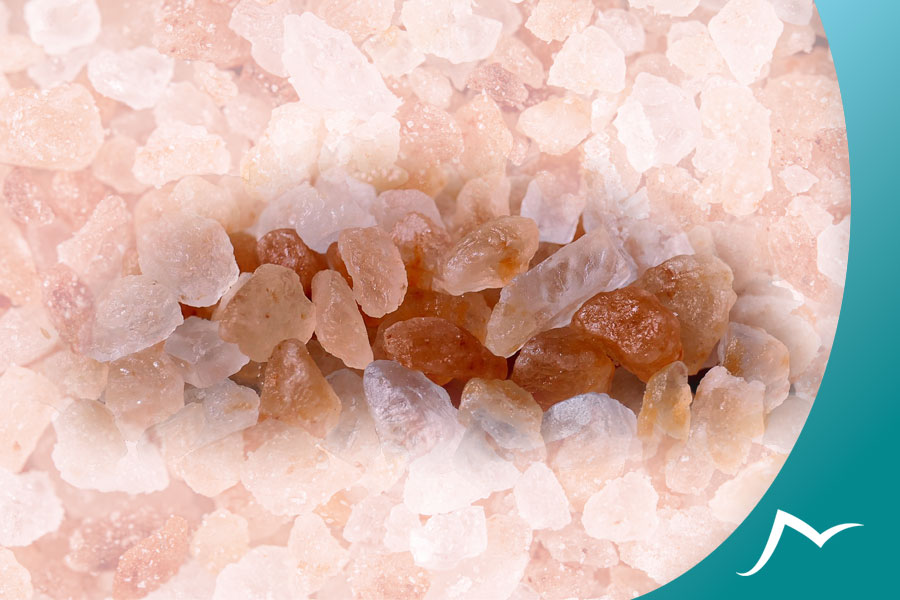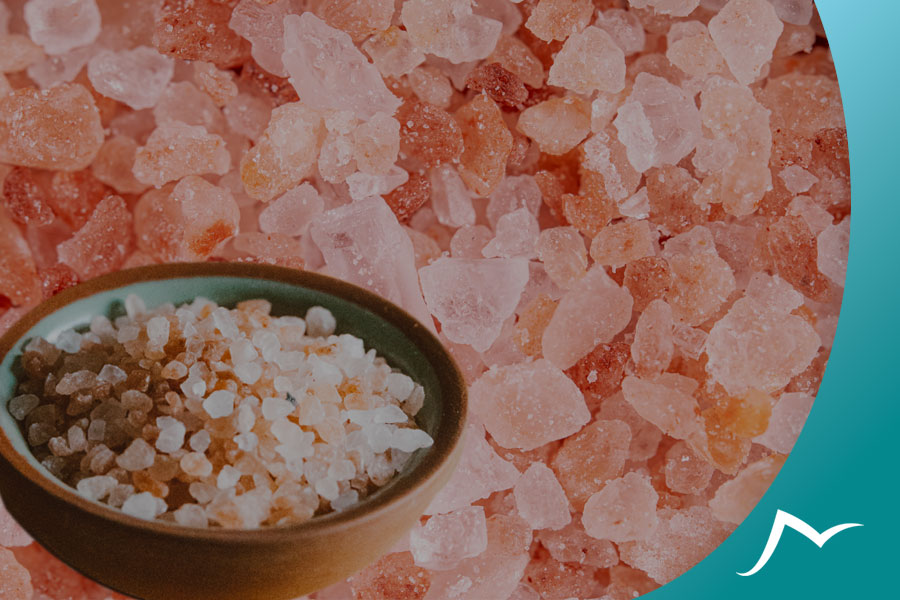Nepal, nestled in the majestic Himalayan Mountains, proudly holds the title of the world’s largest producer of Himalayan salt. This coveted pink-hued salt has gained global recognition for its purity and unique flavor. In this article, we journeyed to uncover the captivating world of Nepal’s Himalayan salt production. We explore its historical significance, economic impact, health benefits, and cultural value. From the ancient origins of Himalayan salt to its demand in the global market, we delve into the exceptional qualities that have made it a favorite among chefs and health-conscious individuals alike. Our objective is to comprehensively explore Nepal’s role as a leading producer, shedding light on its geological advantages, the extraction process, and the sustainable practices employed. By addressing misconceptions and highlighting the health benefits associated with Himalayan salt, we aim to present a holistic perspective on this extraordinary mineral. Join us as we reveal the hidden treasures of Nepal’s Himalayan salt industry and invite readers to appreciate its multifaceted nature.
The Origin and Formation of Himalayan Salt
Himalayan salt, renowned for its purity and exceptional qualities, traces its origins back millions of years. The geological process behind the formation of Himalayan salt deposits is a fascinating tale of ancient seas and tectonic activity. In the remote depths of time, the Indian subcontinent collided with the Asian landmass, giving rise to the majestic Himalayan mountain range. As the collision occurred, ancient seas that once covered the region began to recede, leaving vast salt deposits trapped within the Earth’s crust behind.
Unique Characteristics and Composition of Himalayan Salt
What sets Himalayan salt apart from other types of salt is its distinctive characteristics and mineral composition. This exceptional salt is celebrated for its mesmerizing pink hue, which results from trace minerals such as iron, magnesium, potassium, and calcium. These minerals contribute to its vibrant color and lend a unique flavor profile that is milder and less harsh than traditional table salt. Moreover, Himalayan salt is known for its crystalline structure, which adds an element of visual appeal to culinary presentations.
How Nepal’s Geography Contributes to Salt Production
Nepal’s geography plays a pivotal role in the country’s salt production. Situated in the lap of the Himalayas, Nepal is blessed with vast salt reserves nestled within its mountainous terrains. The geological forces that shaped the Himalayan range preserved these salt deposits, making Nepal a treasure trove of this prized mineral. The unique combination of high altitudes, favorable climatic conditions, and natural springs rich in saltwater all contribute to Nepal’s ability to extract and produce Himalayan salt on a large scale. This geographical advantage has propelled Nepal to the forefront of the global salt industry, cementing its position as the world’s largest producer of Himalayan salt.

The Extraction Process: Mining Himalayan Salt
Mining Himalayan salt is a meticulous process that requires expertise and careful consideration of environmental factors. Various techniques are employed to extract this precious mineral from the depths of the Himalayan Mountains, ensuring its purity and quality.
The primary method of mining Himalayan salt is through traditional hand mining. Skilled miners meticulously carve out salt rocks using hand tools, preserving the natural integrity of the salt deposits. This labor-intensive process allows for a selective extraction that ensures minimal disruption to the surrounding environment.
Nepal has several key locations and mines renowned for their salt extraction. One notable area is the Kali Gandaki River Valley, which is rich in Himalayan salt reserves. The salt mines in this region have been operational for generations, and their products have gained global recognition for their exceptional quality and unique mineral composition.
Environmental considerations have become a crucial aspect of Himalayan salt mining in recent years. Sustainable practices are being implemented to minimize the ecological impact and promote responsible resource management. Measures such as reforestation, land rehabilitation, and water conservation are being adopted to mitigate the potential adverse effects of mining activities.
Furthermore, salt mining companies in Nepal are embracing sustainable practices to ensure the long-term viability of this industry. This includes implementing eco-friendly technologies, utilizing renewable energy sources, and supporting local communities. By prioritizing environmental considerations and sustainable practices, Nepal is striving to maintain its position as the world’s largest producer of Himalayan salt while preserving the natural beauty of its salt-rich landscapes.
Nepal’s Himalayan Salt Industry: An Economic Powerhouse
Nepal’s salt industry holds a significant position within the nation’s economy, making it an economic powerhouse in its own right. The industry contributes substantially to the country’s GDP and plays a vital role in providing employment opportunities to numerous individuals.
The salt industry in Nepal encompasses a range of activities, including mining, processing, packaging, and distribution. It employs a large direct and indirect workforce, creating job opportunities for local communities. The industry’s value chain offers employment across various sectors, from skilled miners and technicians to transporters and marketers.
In addition to its impact on employment, the Himalayan salt industry contributes significantly to Nepal’s national economy. The revenue generated from salt production, both domestically and through exports, strengthens the country’s financial position. The industry’s economic contribution helps support infrastructure development, social welfare programs, and other essential sectors of the economy.
Nepal’s Himalayan salt products have gained international recognition and are exported to numerous countries worldwide. The export market for Himalayan salt continues to expand, with increasing demand for its unique qualities and health benefits. The industry has forged strong international trade partnerships, allowing for distribution of Nepalese Himalayan salt to global markets. These trade relationships contribute to the growth and sustainability of Nepal’s salt industry, further solidifying its position as the world’s largest producer of Himalayan salt.
The success of Nepal’s Himalayan salt industry is a testament to its economic significance, not only within the country but also on a global scale. Through its substantial contribution to the national economy, employment generation, and thriving export market, the industry has established itself as a vital economic powerhouse, fostering growth and prosperity for Nepal and its people.
Health Benefits of Himalayan Salt: Myth or Reality?
Himalayan salt has garnered a reputation not only for its unique flavor but also for its potential health benefits. While some view these claims with skepticism, scientific evidence suggests that Himalayan salt does indeed offer certain advantages over table salt, making it a healthier alternative.
Himalayan salt is renowned for its rich nutritional profile and mineral content. It contains essential minerals such as calcium, potassium, magnesium, and iron, vital for various bodily functions. These minerals contribute to maintaining electrolyte balance, supporting nerve function, regulating blood pressure, and aiding in proper muscle function.

In comparison to table salt, Himalayan salt has a lower sodium content. Excessive sodium intake has been linked to hypertension and other health issues. Individuals can reduce their sodium consumption by using Himalayan salt instead of table salt while still satisfying their taste buds.
Scientific studies have provided evidence supporting the potential health benefits of Himalayan salt. Research suggests it may help improve respiratory conditions, promote better digestion, and aid detoxification. Some studies have also suggested that the minerals present in Himalayan salt may have positive effects on bone health and hydration.
However, it is important to note that while Himalayan salt offers potential health benefits, moderation is key. Like any other salt, excessive consumption should be avoided. Maintaining a balanced diet and consulting healthcare professionals for personalized advice on sodium intake are essential.
While the health benefits of Himalayan salt are not mythical, it is crucial to approach them with a scientific mindset and a balanced approach to overall dietary choices. Incorporating Himalayan salt into a well-rounded, nutrient-rich diet can contribute to a healthier lifestyle, but it should be done with other healthy habits and professional guidance.
Culinary Uses and Flavor Enhancements
Himalayan salt is celebrated not only for its health benefits but also for its versatility and unique flavor profile in the culinary world. Chefs and food enthusiasts around the globe have embraced this exceptional salt, incorporating it into a wide range of dishes and experiencing its delightful flavor enhancements.
One of the remarkable aspects of Himalayan salt is its versatility in culinary applications. It can be used for seasoning, marinating, grilling, baking, and even as a finishing touch to dishes. The delicate yet distinct flavor of Himalayan salt enhances the taste of various ingredients, elevating the overall culinary experience.
Compared to other salts, Himalayan salt offers a unique taste that is milder, less harsh, and subtly nuanced. Its mineral-rich composition imparts a delicate balance of flavors, enhancing the natural characteristics of food without overpowering them. Whether sprinkled on roasted vegetables, used to season grilled meats, or incorporated into salad dressings, Himalayan salt adds a touch of sophistication and complexity to culinary creations.
The popularity of Himalayan salt has led to numerous recipes and dishes that showcase its exquisite flavor. The possibilities are endless, from simple salads and grilled seafood to decadent desserts and artisanal chocolates. Chefs and home cooks alike have embraced Himalayan salt in their creations, experimenting with its unique characteristics to create memorable culinary experiences.
Whether a professional chef or a passionate home cook, incorporating Himalayan salt into your culinary repertoire opens up a world of flavor possibilities. Its versatility, distinct taste, and ability to enhance the natural flavors of food make it a valuable ingredient in the kitchen. So why not embark on a culinary adventure with Nepal’s Himalayan salt and explore its delightful taste sensations?
Himalayan Salt in Beauty and Wellness
Beyond its culinary uses, Himalayan salt has also found its way into beauty and wellness. Its unique properties make it a popular ingredient in skincare products, spa treatments, and home decor.
Himalayan salt is known for its potential benefits in skincare. It is believed to have exfoliating and detoxifying properties, helping to remove dead skin cells and impurities. Some skincare products incorporate finely ground Himalayan salt as an ingredient in scrubs, masks, and bath salts, offering a natural and rejuvenating experience for the skin.
Himalayan salt lamps have gained popularity in recent years, with claims of providing various therapeutic effects. These lamps are crafted from large salt crystals and emit a warm, soothing glow when lit. Supporters of Himalayan salt lamps suggest they can help create a relaxing atmosphere, purify the air by releasing negative ions, and promote well-being.
In addition to skincare and home decor, Himalayan salt is used in bath and body products. Bathing in salt-infused water is believed to have numerous benefits, such as promoting relaxation, soothing muscle aches, and improving skin hydration. Himalayan salt is often incorporated into bath salts, bath bombs, and body scrubs, offering a luxurious and holistic bathing experience.
It is important to note that while Himalayan salt has gained popularity in the beauty and wellness industry, scientific evidence supporting its specific therapeutic effects is limited. As with any wellness practice or skincare regimen, individual experiences may vary, and it is advisable to consult with professionals and prioritize personal preferences.
Nevertheless, the allure of Himalayan salt in beauty and wellness continues to captivate individuals seeking natural and holistic approaches to self-care. Whether indulging in a spa treatment, creating a relaxing ambiance with a salt lamp, or enjoying a salt-infused bath, incorporating Nepal’s Himalayan salt into your beauty and wellness routine can add a touch of tranquility and a sense of connection to nature.
Exploring Nepal’s Himalyan Salt Regions
Nepal has several notable salt-producing regions with unique characteristics and historical significance. These regions have played a vital role in shaping the country’s salt industry and maintaining its position as the world’s largest producer of Himalayan salt.
One of the prominent salt-producing regions in Nepal is the Kali Gandaki River Valley. Located in the western part of the country, this region boasts abundant salt reserves and has a long-standing history of salt production. The salt mines in this area have been a significant source of livelihood for local communities for generations.
The salt-producing regions of Nepal hold immense cultural significance and historical value. Salt has played a pivotal role in these regions’ traditions, customs, and trade. In ancient times, salt was a precious commodity traded across the Himalayan region, shaping the economy and fostering cultural exchanges between communities.
Local communities in these salt regions have a deep-rooted relationship with salt production. They have inherited traditional knowledge and techniques passed down through generations, preserving the art of salt mining and processing. The extraction of salt is not only a means of livelihood but also a part of their cultural identity and heritage.
The relationship between local communities and salt production goes beyond economic ties. It is a harmonious coexistence where communities rely on natural resources while respecting and nurturing the surrounding environment. The sustainable practices these communities adopt ensure the preservation of salt reserves for future generations and maintain the delicate balance between human activities and nature.
Exploring Nepal’s salt regions offers a glimpse into the rich cultural tapestry, historical significance, and close-knit relationship between local communities and salt production. It is an opportunity to witness the harmonious integration of tradition, livelihood, and natural resources, showcasing Nepal’s unique bond with its status as the world’s largest producer of Himalayan salt.
Challenges and Sustainability Practices in Nepal’s Himalayan Salt Production
While being a significant industry, Himalayan salt production is not without its challenges. These challenges encompass environmental impacts, social issues, and the need for sustainable practices to ensure the long-term viability of salt production in Nepal.
Salt mining, like any extractive industry, can have environmental consequences. The excavation of salt rocks and the associated processes can disrupt ecosystems, affect water resources, and alter natural landscapes. However, measures are being taken to mitigate these impacts. Companies and communities involved in salt production are adopting sustainable practices to minimize their environmental footprint. This includes reforestation efforts, water management strategies, and the implementation of responsible mining techniques to reduce soil erosion and promote land rehabilitation.
Salt workers face social challenges that must be addressed for a more sustainable salt industry. These challenges include fair wages, safe working conditions, and the recognition of their rights. The well-being and livelihoods of salt workers should be safeguarded, ensuring their inclusion and empowerment within the industry. Initiatives focusing on improving working conditions, providing access to education and healthcare, and promoting fair trade practices are essential for the sustainable development of salt-producing communities.
Promoting sustainable practices in Himalayan salt production goes beyond environmental and social considerations. It also involves fostering community development and empowerment. Supporting local communities by providing them with the necessary resources, training, and infrastructure not only improves their quality of life but also strengthens the salt industry as a whole. By engaging in community development initiatives, such as educational programs, healthcare facilities, and skill-building opportunities, the industry can positively impact the lives of salt workers and their families.
The challenges the Himalayan salt industry faces are being addressed through sustainable practices and community-focused approaches. Efforts are being made to mitigate environmental impacts, uphold the rights and well-being of salt workers, and promote the development of salt-producing communities. By recognizing and addressing these challenges, Nepal’s salt industry can continue to thrive as the world’s largest producer of Himalayan salt while ensuring a sustainable and responsible approach to production.
The Global Demand for Himalayan Salt
Himalayan salt has gained immense popularity globally, driven by increasing consumer awareness of its unique qualities and health benefits. The growing demand for this coveted salt presents both opportunities and challenges for Nepal’s salt industry as the world’s largest producer.
Market trends indicate a rising global demand for Himalayan salt across various industries. In the culinary sector, chefs and food enthusiasts seek out Himalayan salt’s distinct flavor and mineral-rich composition, incorporating it into their recipes and culinary creations. Additionally, the beauty and wellness industry has witnessed a surge in the use of Himalayan salt in skincare products, spa treatments, and even home decor items like salt lamps. The unique properties of Himalayan salt have made it a sought-after ingredient, driving its global demand.
Importing countries play a crucial role in the global market for Himalayan salt. Countries such as the United States, Canada, Germany, the United Kingdom, and Australia are among the major importers. These countries have witnessed a growing demand for natural and healthier alternatives to conventional table salt, leading to increased imports of Himalayan salt. Furthermore, emerging markets in Asia, including China, India, and South Korea, are also showing a growing interest in Himalayan salt, presenting new market opportunities for Nepal’s salt industry.
While the global demand for Himalayan salt opens up opportunities for Nepal, it also brings certain challenges. Increasing demand requires efficient production, quality control, and distribution systems. Ensuring consistent supply to international markets while maintaining the integrity and authenticity of Himalayan salt is crucial. Furthermore, competition from other salt-producing countries and the need to comply with international trade regulations pose additional challenges for Nepal’s salt industry.
To effectively leverage the global demand for Himalayan salt, Nepal’s salt industry must focus on quality assurance, innovation, and market diversification. Collaborations with international buyers, exploring new product development, and improving production and packaging techniques can help capitalize on the growing market trends. Additionally, establishing strong trade partnerships, participating in trade fairs and exhibitions, and promoting Nepal’s unique selling points as the world’s largest producer of Himalayan salt can enhance the country’s position in the global market.
Navigating the global demand for Himalayan salt requires a strategic approach and continuous adaptation to evolving market dynamics. By understanding the demand drivers, identifying emerging markets, and addressing challenges, Nepal’s salt industry can seize the opportunities presented by the global market and further strengthen its position as the world’s largest producer of Himalayan salt.
The Cultural Significance of Himalayan Salt in Nepal
Himalayan salt holds deep cultural significance in Nepal, permeating various aspects of Nepali culture, traditions, and rituals. It is not just a commodity but a symbol of heritage and an integral part of the country’s cultural fabric.
Salt is significant in Nepali culture, associated with purity, preservation, and prosperity. It is considered essential for auspicious occasions, rituals, and traditional ceremonies. From birth ceremonies to marriage rituals and even funeral rites, salt is used symbolically to bless and sanctify the proceedings, representing the preservation of traditions and the well-being of individuals.
Salt festivals hold immense importance in Nepali society, showcasing the cultural significance of Himalayan salt. One such festival is the “Nuna Festival,” celebrated by the indigenous Magar community. During this festival, villagers gather to express gratitude for the salt and honor the salt-bearing deity. The festival involves cultural performances, traditional dances, and rituals centered around salt, reflecting the deep-rooted connection between the community and the salt they produce.
Folklore and stories associated with Himalayan salt further illustrate its cultural significance. These tales are passed down through generations, emphasizing salt’s value and mystical properties. Legends of salt-bearing animals, mythical creatures guarding salt deposits, and divine origins of salt highlight the reverence and awe that salt holds in Nepali folklore.
The cultural significance of Himalayan salt in Nepal goes beyond its practical uses or economic value. It is deeply intertwined with the country’s history, traditions, and collective identity. Salt bridges the past and the present, connecting Nepali communities with their ancestors and the natural resources that sustain them.
By understanding the cultural significance of Himalayan salt in Nepal, we gain insight into the profound relationship between the people, their traditions, and the salt they produce. It showcases the enduring power of salt as more than a mere commodity but as a vessel of culture, heritage, and spiritual significance.
Himalayan Salt as a Sustainable Industry
Himalayan salt production in Nepal is not just about being the world’s largest producer; it is also committed to sustainability and responsible practices. Efforts are underway to promote sustainable salt production, ensuring the industry’s long-term viability while prioritizing environmental conservation and community welfare.
Various initiatives have been implemented to promote sustainable salt production in Nepal. These initiatives focus on optimizing resource utilization, minimizing waste generation, and adopting environmentally friendly techniques. For example, salt producers are exploring innovative mining methods that reduce their ecological footprint, such as using less invasive extraction techniques and implementing efficient water management practices to minimize water usage during salt processing.
Fairtrade and ethical practices are central to the sustainability of the Himalayan salt industry. Efforts are being made to ensure that salt workers receive fair wages and are provided with safe working conditions. Fairtrade certification programs are being implemented, guaranteeing that salt is produced and traded ethically and socially responsibly. These programs help protect salt workers’ rights and ensure they receive just compensation for their labor.
Environmental conservation is a key aspect of sustainable salt production. Measures are being taken to protect and preserve the surrounding ecosystems. Reforestation projects are being undertaken to restore vegetation and prevent soil erosion in salt-producing regions. Additionally, initiatives are focused on minimizing the impact of salt mining on water resources, ensuring the sustainable use and management of water throughout the production process.
Community welfare projects are also integral to the sustainable development of the Himalayan salt industry. Efforts are being made to improve the living conditions of salt-producing communities, providing access to education, healthcare, and other essential services. Additionally, initiatives aim to empower local communities by providing them with training opportunities, supporting income-generating activities, and fostering social and economic development.
The Himalayan salt industry in Nepal is committed to sustainability, promoting fair trade practices, environmental conservation, and community welfare. By implementing responsible production methods, ensuring ethical practices, and supporting initiatives for environmental and social well-being, the industry strives to maintain its position as the world’s largest Himalayan salt producer while safeguarding this valuable resource’s future.
The Future of Nepal’s Salt Industry
The future of Nepal’s salt industry holds immense promise, driven by innovations, market projections, and government support. With its position as the world’s largest producer of Himalayan salt, Nepal is well-positioned to capitalize on the growing global demand and shape the industry’s future.
Innovations and advancements in Himalayan salt production pave the way for a more efficient and sustainable industry. Salt producers invest in research and development to enhance mining techniques, processing methods, and quality control measures. These innovations aim to optimize production, improve product consistency, and meet international standards, further strengthening Nepal’s position in the global market.
Market projections indicate a positive growth trajectory for the Himalayan salt industry. The increasing awareness of the unique qualities and health benefits of Himalayan salt among consumers worldwide is expected to increase demand. As more people seek natural and healthier alternatives to conventional salt, the market for Himalayan salt is projected to expand. This presents significant growth potential for Nepal’s salt industry, offering increased production, exports, and economic growth opportunities.
Nepal’s government recognizes the salt industry’s importance and provides support through policies and initiatives. The government has implemented measures to streamline licensing procedures, facilitate trade, and promote investment in the salt sector. Additionally, policies are in place to ensure sustainable salt production, environmental conservation, and the well-being of salt workers. The government’s commitment to the salt industry provides a favorable environment for its growth and development.
The future of Nepal’s salt industry hinges on continued innovation, market awareness, and government support. By embracing technological advancements, expanding market reach, and leveraging government policies, the industry can sustain its position as the world’s largest producer of Himalayan salt. With a focus on quality, sustainability, and meeting the evolving demands of consumers, Nepal’s salt industry is poised for a bright future, contributing to the country’s economic growth and global reputation as a leading producer of this coveted natural resource.
Conclusion
Nepal proudly holds the title of the world’s largest producer of Himalayan salt, a remarkable achievement stemming from its unique geography and rich salt deposits. Throughout this article, we have explored Nepal’s salt industry from various angles, highlighting its economic, health, cultural, and environmental significance.
Economically, Nepal’s salt industry plays a vital role in contributing to the national economy and creating employment opportunities. With the increasing global demand for Himalayan salt and the industry’s growth potential, Nepal’s salt producers and exporters have a promising future.
Himalayan salt stands out for its mineral-rich composition, offering potential health benefits and serving as a healthier alternative to table salt. Culturally, it holds a deep significance in Nepali traditions, rituals, and festivals, symbolizing purity, preservation, and prosperity.
From an environmental perspective, efforts are being made to ensure sustainable salt production, minimize ecological impact, and support community welfare. Supporting Nepal’s salt industry through choosing authentic products and fair trade practices can contribute to salt workers’ livelihoods and the industry’s sustainable growth.
In conclusion, Nepal’s position as the world’s largest producer of Himalayan salt showcases its geological endowments, cultural heritage, and commitment to sustainability. Let us appreciate and support Nepal’s salt industry, recognizing its valuable contributions to our lives and the world. Embracing the benefits of Himalayan salt connects us to Nepal’s rich traditions and natural wonders.
FAQs
What makes Nepal the world’s largest producer of Himalayan salt?
Nepal’s abundant salt deposits and unique geological conditions contribute to its position as the largest producer.
What are the benefits of Himalayan salt compared to table salt?
Himalayan salt contains a wide range of minerals and may offer additional health benefits compared to table salt.
How does Himalayan salt contribute to Nepal’s economy?
The salt industry in Nepal contributes significantly to the national economy through export revenues and employment generation.
Are there any environmental concerns associated with Himalayan salt production in Nepal?
There are environmental considerations related to salt mining, but efforts are being made to mitigate the impact and promote sustainable practices.
What are some popular culinary uses of Himalayan salt?
Himalayan salt is versatile and can be used for seasoning, grilling, curing, and even creating salt blocks for cooking and serving.
Can Himalayan salt be used for skin care and wellness purposes?
Yes, Himalayan salt is known for its use in skincare products, spa treatments, and bath soaks due to its potential benefits for exfoliation and relaxation.
Which regions in Nepal are known for salt production?
Notable salt-producing regions in Nepal include the Kulekhani, Tistung, and Jomsom areas, among others.
What is the cultural significance of Himalayan salt in Nepal?
Himalayan salt holds cultural importance in Nepali traditions, rituals, and festivals, symbolizing purity and prosperity.
Are there any fair trade initiatives supporting Nepal’s salt industry?
Yes, there are fair trade programs to ensure ethical practices, fair wages, and safe working conditions for salt workers in Nepal.
Which countries import Himalayan salt from Nepal?
Countries such as the United States, Canada, Germany, and the United Kingdom are among the importers of Himalayan salt from Nepal.
Is there scientific evidence supporting the health benefits of Himalayan salt?
While scientific research is ongoing, some studies suggest potential health benefits associated with Himalayan salt due to its mineral content.
How does the government of Nepal support the salt industry?
The government supports the salt industry through policies that promote sustainable production, trade facilitation, and investment opportunities.
Are there ongoing efforts to promote sustainability in Himalayan salt production?
Yes, initiatives are being undertaken to minimize the environmental impact of salt mining, promote community welfare, and adopt sustainable practices.
What is the future outlook for Nepal’s salt industry?
The future looks promising, with advancements in production techniques, growing market demand, and government support creating opportunities for growth and development in the industry.




Pink salt has immense benefits and is one of the most slept-upon secrets in this world. Hope more people know about this throughout the world. We have substituted table salt and use pink salt exclusively.